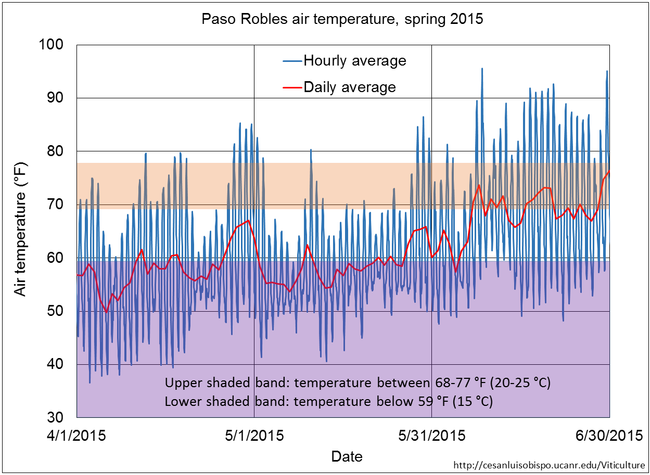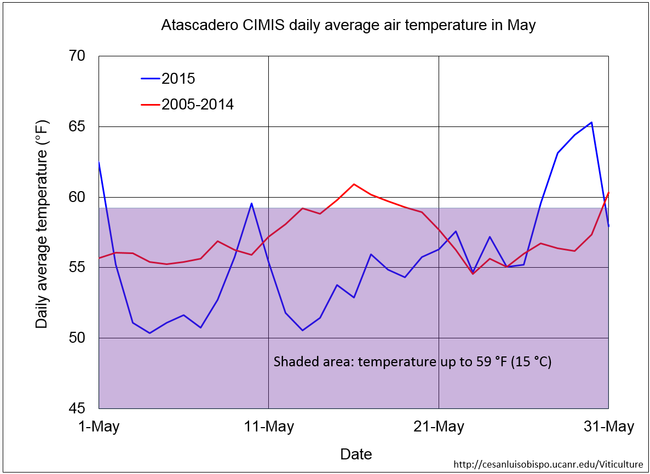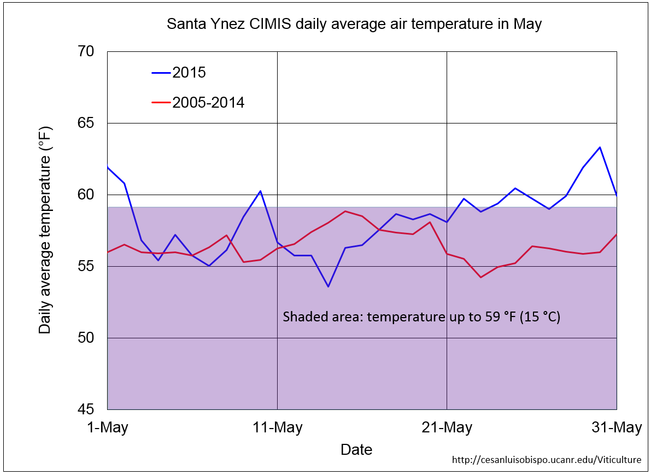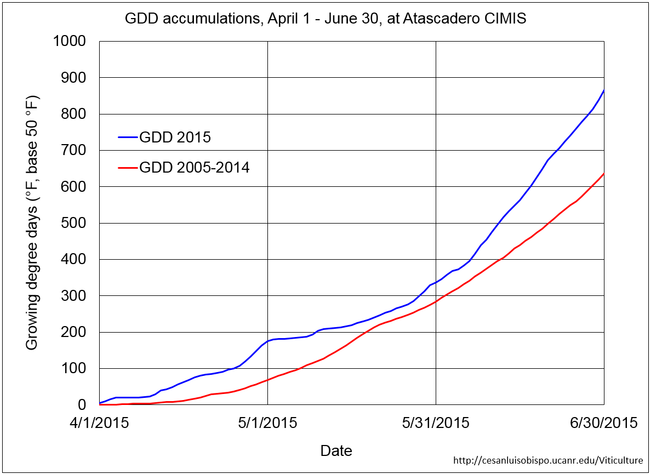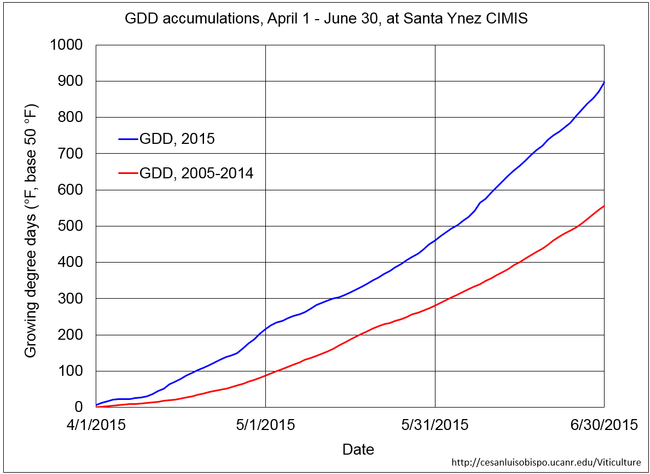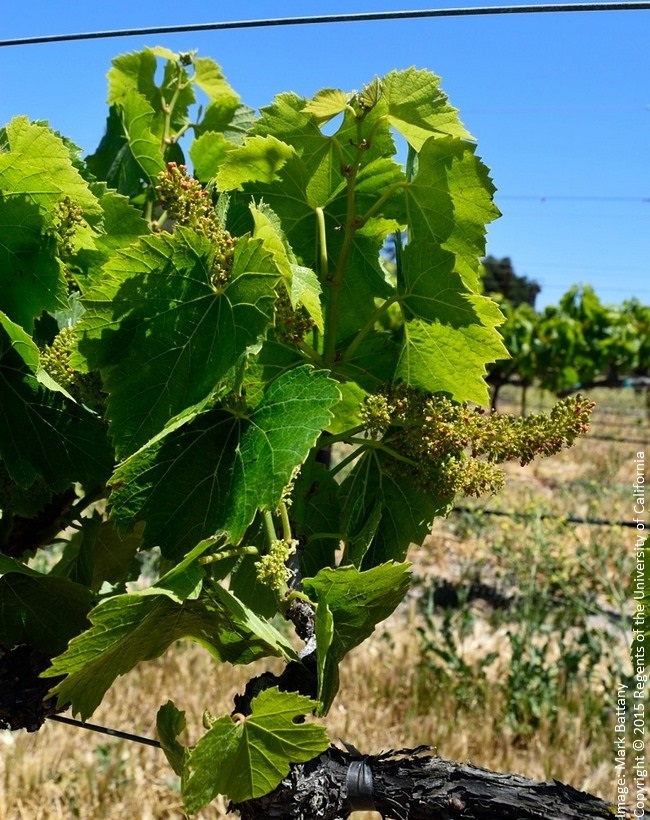The 2015 season will be remembered for the very low crop yields in some areas of the Central Coast due to the very poor fruit set in the spring. Lower than average yields were also observed in other regions of California, indicating the widespread impact of the cool spring temperatures. However the extremely poor fruit set observed in numerous local vineyards, particularly in the Paso Robles area, suggests that factors in addition to the cool spring weather had made this problem more severe in this region. In particular, the drought conditions that have impacted the region over the past several years likely played a role in the poor fruit set as well.
In Figure 2 below, the hourly and daily average air temperatures at a UC weather station east of Paso Robles are shown for the months of April through June of 2015. The lower shaded area indicates temperatures up to 59 °F (15 °C); grapevine flowers begin opening around this temperature, and stronger flower opening occurs once temperatures are in the range of 68 – 77 °F (20 – 25 °C) (upper shaded band)1. Thus much of May experienced air temperatures that corresponded to less than optimal flowering conditions.
In Figure 3 below, a comparison of the 2015 temperatures is made against the average of the 2005-2014 seasons until at the Atascadero CIMIS station, for the month of May. For most of the month the 2015 temperatures were substantially lower than the average of 2005-2014 seasons at the station (note that this site tends to be slightly cooler than much of the Paso Robles area).
In Figure 4 below, a similar comparison is made for the same 2015 and 2005-2014 data at the Santa Ynez CIMIS station. The 2015 temperatures are not much different than the long-term average since 2005; this suggests that more than just cool temperatures were resulting in the poor fruit set observed at some sites in that region in 2015.
Comparisons of degree-day accumulations from April 1 through June 30 are another way to appreciate how much 2015 differed from the average conditions for the respective areas. In Figure 5 below, the GDD accumulation for the Atascadero station shows a clear "flat spot" corresponding to the cool May period. The vine growth rate would have been expected to be below average during this period, which is what many growers observed; vines which had experienced an early bud break and rapid growth in April had very much slowed down in their development through May.
The Santa Ynez CIMIS site did not show the same "flat spot" in May (Figure 6 below); instead it experienced uniformly warmer-than-average degree-day accumulations throughout the spring.
The severe drought of the past several years has impacted both San Luis Obispo and Santa Barbara Counties particularly harshly relative to other coastal wine grape areas in the state. In May 2015 the region was still ranked as being under 'Exceptional' drought conditions (map). With soils being extremely dry outside of the relatively small soil volume typically wetted with drip irrigation, it was easy for growers to find themselves "behind the curve" on irrigation even fairly early in the spring, with vines suffering from water stress much earlier than would ever occur under more normal conditions. Leaching of accumulated salts has also been greatly reduced with the lack of rainfall in recent years, and the resulting higher soil salinity levels have also increased the water stress on vines. As a result of these additional stresses, some vineyards had produced relatively little shoot growth in the spring by bloom (Figure 7 below).
Vines with less foliage may not set fruit as well as vines having more foliage; this was shown in the 1920s in experiments carried out by A.J. Winkler with the University of California2. He pruned vines to different numbers of buds, thus creating vines with different amounts of foliage during the springtime, but he thinned the flower clusters before bloom so that all treatments would have the same number of flower clusters as on his spur-pruned control vines. He observed that as the spring foliage levels increased (due to having more shoots from more retained buds), that both the viability of the flower pollen and the resulting fruit set increased. Thus the limited spring foliage levels and low photosynthesis rates due to the cool temperatures were likely important contributing factors to the very poor fruit set at some sites.
The highly variable influences of soil moisture availability, salinity stress, and early season foliage production can help explain why growers in the same local area often experienced very different fruit set outcomes. Cabernet Sauvignon in the Paso Robles area offers a good example; it was severely affected at numerous locations with extremely poor fruit set resulting in sub 1-ton per acre yields, while other vineyards of the same variety had more or less normal crop loads. All experienced roughly the same temperature conditions.
Some growers also experienced very different fruit set levels on spur-pruned compared to cane-pruned vines of the same variety in the same area (Figure 8 below). Spur-pruned vines tend to show greater uniformity in bud break and shoot growth as compared to cane-pruned vines; their more uniform shoot development means that their flowering also tends to occur over a more uniform and hence shorter time period. As a result, spur-pruned vines may suffer more from poor fruit set conditions if these conditions happen to coincide with their relatively narrow window of flowering. Cane-pruned vines, with their less uniform bud break and shoot development, may have fared better in this regard because their flowering occurred over a longer time period, and thus they were less susceptible to damage from short-term cool temperature conditions.

